Pregnancy is a life-altering experience and requires a lot of preparation. One needs to be fully aware of the challenges of birthing a new life and caring for it.
Expecting mothers may balance their lifestyles by including the right amount of rest, food, and physical and mental exercise in their daily routines. Pre-natal Yoga has amassed a lot of attention and popularity for providing pregnant women with one of the best health regimens for one’s mental and physical wellness.
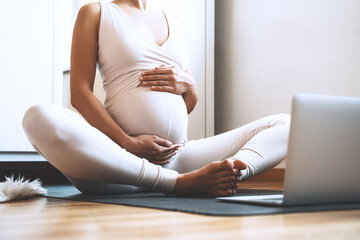
What Is Pre Natal Yoga?
Pre-natal Yoga includes a combination of Yoga postures, meditation techniques, and breathing exercises designed exclusively for pregnant women. Pre-natal Yoga helps pregnant women to develop a robust physique and nurture their mental health. The activities included in pre-natal Yoga allows women to handle the challenging experiences of pregnancy and childbirth.
Every woman is different and may need a customized pre-natal Yoga plan to guide her through pregnancy. Expectant mothers are strongly recommended to follow a Yoga routine under the supervision and guidance of a certified Yoga instructor. Your instructor will make a Yoga plan after considering every aspect of your health and pregnancy. It is possible that your instructor may need to communicate with your gynecologist to make your Yoga journey more impactful and helpful.
Let us get to know the benefits of practicing Yoga during pregnancy.
Benefits Of Yoga During Pregnancy
Stronger Muscles
Pregnancy brings a lot of changes to women’s physiques. Women’s bodies evolve, and most abdominal and pelvic organs make room for the life growing inside them. The uterus expands more than 50 times its size during pregnancy. Pre-natal Yoga strengthens the muscles to adjust to the pregnancy changes.
- Enhanced Hormonal Circulation
The levels of reproductive hormones are very different for pregnant and non-pregnant women. Yoga postures and meditation maintain the levels of hormones that are important to carry forward a healthy pregnancy. Pregnant women often experience random elevation or depression in their blood sugar levels owing to hormonal disturbances. Pre-natal Yoga prevents such occurrences and maintains a healthy metabolism. Yoga also positively affects thyroid functions and balances the hormones that control the body’s nutritional needs.
- Better Flexibility
Yoga is one of the best ways to increase body flexibility. Women’s bodies undergo considerable changes during pregnancy and after childbirth. Increased flexibility of the abdominal, pelvic, and lower limb muscles eases the process of giving birth. Women who practice pre-natal Yoga may recover faster from muscular soreness, body pain, and exhaustion from delivering a baby.
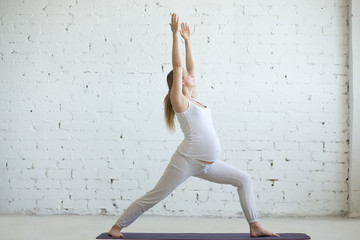
- Improved Sleep Cycle
The internal hormonal storm that rages during pregnancy can take a toll on the sleep cycle. Pre-natal Yoga includes meditation techniques and breathing exercises that calm your mind and body, allowing you to sleep better. Pregnant women need adequate rest to nurture themselves and their unborn babies. Pre-natal Yoga is the best way to get the sleep and rest required for a healthy pregnancy.
- Reduced Anxiety And Fear
“Childbirth is a breeze,” said no woman ever. Listening to other women narrate their pregnancy stories may incite anxiety and fear about the whole process. Yoga postures, meditation, and breathing techniques will soothe agitated nerves and retain mental calm. Meditation allows you to focus better on yourself and your baby during pregnancy and childbirth.
- Lesser Morning Sickness
Waking up every day to spend an hour or two throwing up is the harsh reality of pregnancy. Morning sickness can range from mild nausea to frequent vomiting and may require medical treatment. Some Yoga postures that improve digestion also help to reduce the discomfort that morning sickness causes.

Yoga and meditation are beneficial in maintaining good physical and mental well-being during pregnancy and childbirth. Pre-natal Yoga techniques also play a crucial role in reducing physical symptoms and mental uneasiness that occur commonly after childbirth.
5 Yoga Poses To Practice During Pregnancy
Here are five relaxing Yoga postures that relieve pregnant women’s discomfort.
- Baddha Konasana
Baddha Konasana is a seated Yoga pose having a profound positive effect on the pelvis, lower abdomen, and thighs. Pregnant women may perform Baddha Konasana to obtain relief from heaviness and pain in the lower back that occurs during the later stages of pregnancy.
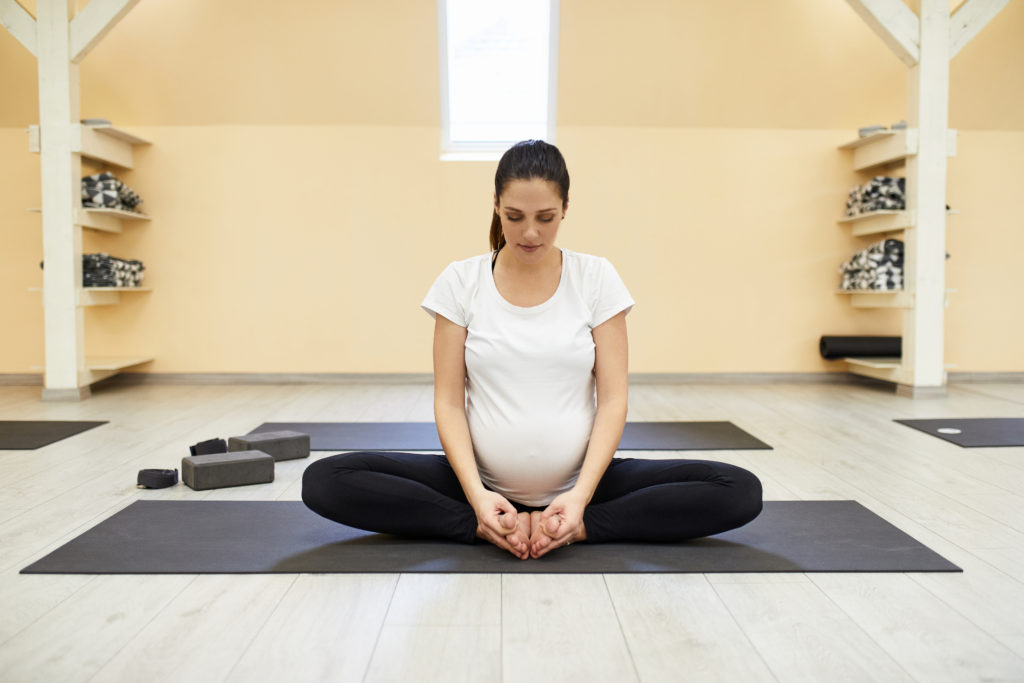
- Sit comfortably on the ground to perform Baddha Konasana or the butterfly pose.
- Position your legs straight ahead and close to one another without bending your knees.
- Now bend both knees simultaneously till they are as close to the chest as possible, without pressing your pregnant belly.
- Drop both your knees sideways so that they are close to the ground.
- Hold both feet and press them firmly against the ground. Maintaining an erect spine will relieve your sore back muscles.
- Remain in Baddha Konasana for as long as it is comfortable before relaxing your body.
- Malasana
Malasana is a squatting Yoga posture best suited to women in an advanced stage of pregnancy. Mala is a Sanskrit language word that means necklace or garland. Malasana is rightfully named because your arms’ position during the posture resembles a garland.
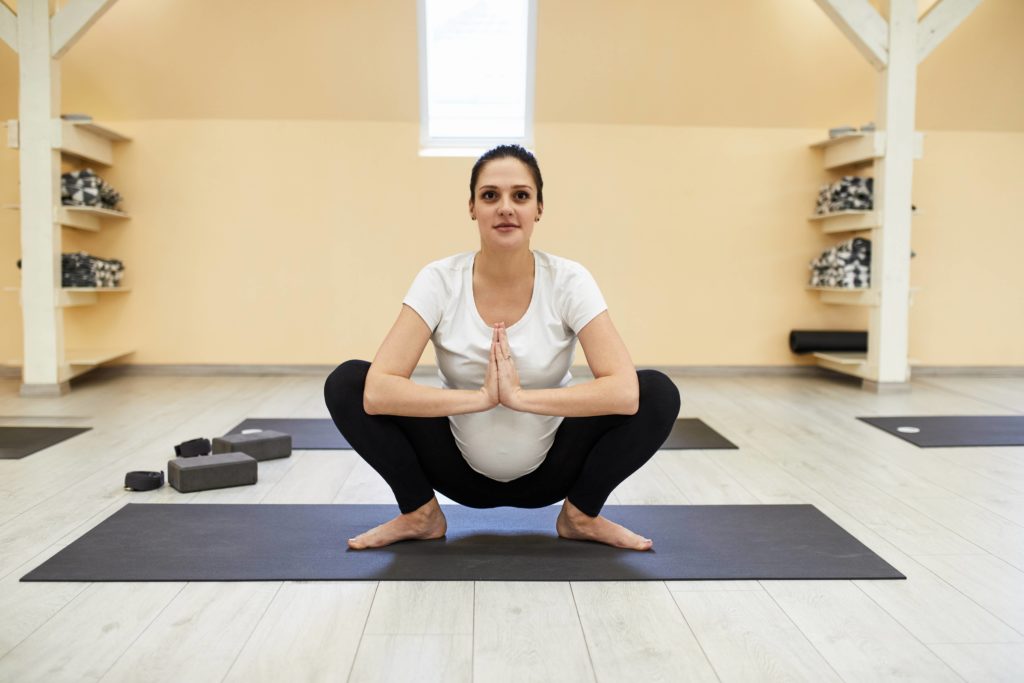
- Standing straight with some distance between your feet is the best way to begin Malasana.
- Get into a squatting position without resting your buttocks on the ground.
- Try to keep your feet parallel to one another without turning them outward.
- Now touch your palms as if in prayer and keep them close to your chest. Press your elbows firmly to the inner side of the corresponding thigh.
- In the final position of Malasana, the muscles of your groins, inner thighs, lower back, and pelvis are adequately stretched.
- Look straight ahead and continue regular breathing throughout Malasana.
- Setu Bandhasana
The bridge pose or Setu Bandhasana is a lying down Yoga posture that allows easy digestion during pregnancy. The pose also strengthens your spine and thighs, which may reduce the pains experienced during childbirth.
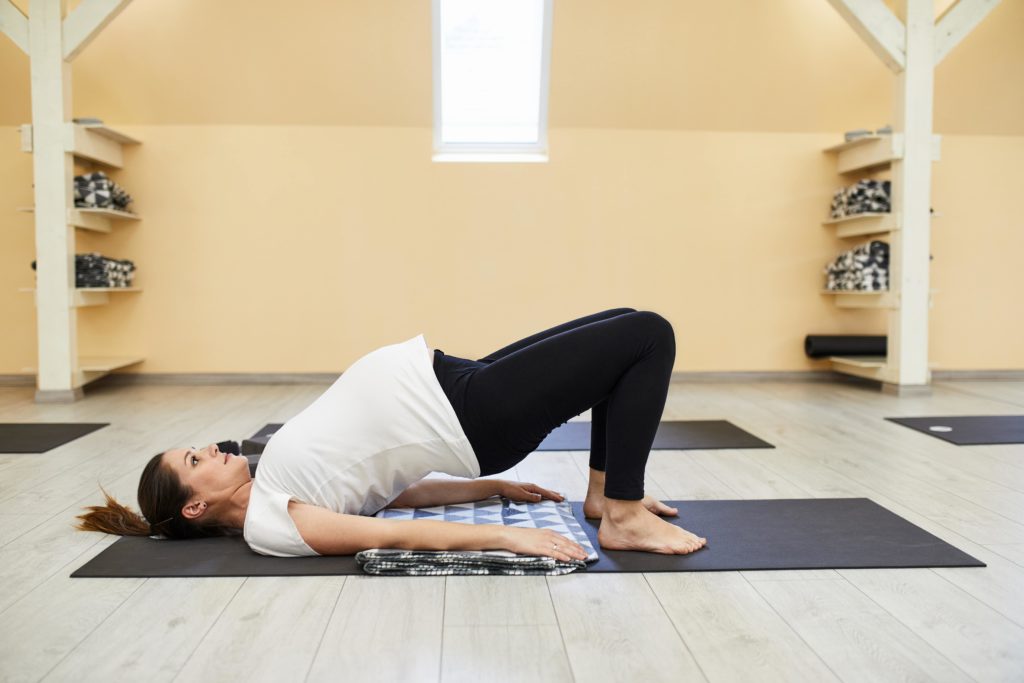
- To begin the bridge pose, lie on your back with your arms and legs resting by the side.
- Bend both knees till you can bring your feet as close to your buttocks as possible.
- For a more effective Setu Bandhasana, keep some distance between your feet.
- Press your arms, palms, and feet firmly against the ground to support your body during Setu Bandhasana.
- Elevate your thighs, hips, and trunk while balancing the body weight on your arms and feet.
- Remain in the bridge pose for up to 5 breathing cycles before relaxing your body.
Setu Bandhasana is suitable only during the first six months of pregnancy, after which pregnant women should refrain from performing it.
- Vrikshasana
Vrikshana is a standing Yoga pose, also known as the tree pose. The name is suitable for Vrikshasana since you will assume the steady posture of a well-branched tree while performing the asana. A growing pregnant belly is likely to disturb the natural balance and coordination of the human body. Vrikshasana restores lost balance and also strengthens the lower limb muscles.
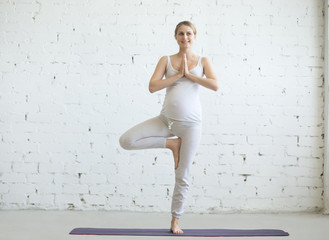
- Start by standing on your Yoga mat with your feet aligned slightly away from one another.
- Maintain an erect posture and relax your arms by the side of your body.
- Elevate your right foot by bending the knee and placing it firmly against the inner side of the left thigh. Ensure that the entire right foot is in complete contact with the left inner thigh.
- Join your palms as if in prayer and place them close to your chest.
- You may take support from an adjoining wall or a piece of heavy furniture to balance your posture.
- Remain in Vrikshasana for as long as you find comfortable before relaxing your body.
- Repeat the posture with your left leg.
- Trikonasana
Trikonasana, Utthita Trikonasana, or the triangle pose, is a standing Yoga posture that mimics the shape of a triangle. Trikonasana stretches the limbs and sides of the body adequately, thereby releasing muscular tension and stiffness. Pregnant women may benefit from Trikonasana as it relieves anxiety and mental and physical stress.
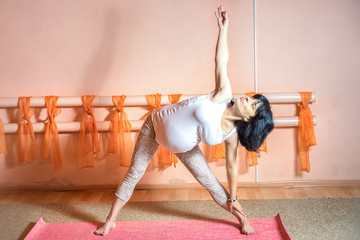
- To perform Trikonasana, stand on a flat, firm surface with a distance of 3-4 feet between your legs.
- Maintain an erect posture without slouching your back or shoulders during Trikonasana.
- Elevate both arms simultaneously till they are parallel to the floor.
- Turn your right foot, knee, and thigh outward by 90 degrees. Turn your left foot inward till its toes point towards the right heel.
- Bend your body towards the right side from your hips till you can grab your right shin with your right hand.
- Elevate your left arm till your fingers point towards the ceiling and fix your gaze on them.
Remain in Trikonasana as long as you feel comfortable before repeating the posture with your left limbs.
Things To Remember
Pre-natal Yoga is an excellent tool for expecting mothers to remain in good shape and have a stress-free pregnancy. However, not all forms of pre-natal Yoga may suit everyone. It is imperative to focus on the below points before starting pre-natal Yoga.
- Different Yoga postures are suited for different stages of pregnancy. You may get together with your Yoga trainer and form a plan suited to your pregnancy needs.
- Learn and practice pre-natal Yoga under the direct supervision of a certified and experienced Yoga trainer.
- Discontinue all Yoga postures that cause you even the slightest discomfort. Seek prompt medical aid or consult with your Yoga trainer at the earliest.
- Do not begin pre-natal Yoga unless your doctor and your Yoga trainer green-light the fitness regimen.
- Breathing exercises may impact your abdominal and pelvic muscles. Consult with your Yoga trainer to know which breathing techniques suit your current stage of pregnancy.
- The same Yoga posture that suits one pregnant woman may not essentially be suitable for another.
Pre-natal Yoga immensely benefits a pregnant woman’s mental and physical well-being when practiced with caution.
Watch this space to learn about the Yoga Mudras that benefit pregnant women.







